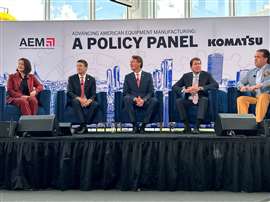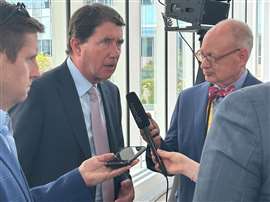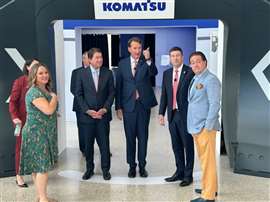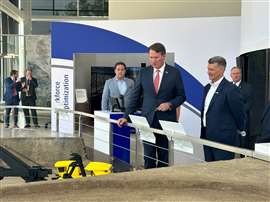Republicans visit Komatsu to set out a vision for US construction’s future
19 July 2024
On 15 July, the first morning of the Republican National Convention (RNC) in Milwaukee, Wisconsin, US, three party representatives – Virginia Governor Glenn Youngkin, US Senator from Tennessee Bill Hagerty and House of Representatives member from Wisconsin Bryan Steil – took part in a policy panel at Komatsu’s Milwaukee South Harbor campus.
 The 15 July AEM policy panel at the Komatsu manufacturing facility in Milwaukee, Wisconsin, US. Flanked by the moderators are three elected US Republican officials: US Congressman from Wisconsin Bryan Steil, Virginia Governor Glenn Youngkin and US Senator from Tennessee Bill Hagerty. (Image: Mitchell Keller)
The 15 July AEM policy panel at the Komatsu manufacturing facility in Milwaukee, Wisconsin, US. Flanked by the moderators are three elected US Republican officials: US Congressman from Wisconsin Bryan Steil, Virginia Governor Glenn Youngkin and US Senator from Tennessee Bill Hagerty. (Image: Mitchell Keller)
The event was held at Japan-based Komatsu’s Milwaukee manufacturing facility and the panel discussion was co-hosted and curated by the Association of Equipment Manufacturers (AEM). It was titled ‘Advancing American Equipment Manufacturing: A Policy Panel’.
While the focus of the panel was on US manufacturing, the policy direction discussed by the trio of Republicans would have a direct effect on the construction industry, as well.
Komatsu America chairman and CEO Rod Schrader alluded to manufacturing’s broad influence while introducing the panel.
“We build equipment that answers the needs of society,” he said. “I would say those needs aren’t going away. In fact, as the world population continues to grow and become more connected through the global flow of goods, services, capital, data, and ideas, equipment manufacturers will be increasingly counted on to build, feed and power the world.”
The panel discussed several ways to help the US manufacturing and construction industries achieve this, but the three elected officials spoke at length about deregulating the built environment, and education.
Republicans’ top priority is deregulation
“We have a huge problem,” said Senator Hagerty, “and that’s overregulation.”
 Republican US Senator from Tennessee Bill Hagerty talks with press at the Komatsu facilty in Wisconsin. (Image: Mitchell Keller)
Republican US Senator from Tennessee Bill Hagerty talks with press at the Komatsu facilty in Wisconsin. (Image: Mitchell Keller)
It was one of the topics discussed the most during the approximately hour-long talk, with each member analysing in detail how removing ‘red tape’ can benefit manufacturers and builders.
The trio said the US Supreme Court’s recent rejection of the Chevron deference – a mechanism by which US departments and agencies had broad authority to interpret and enforce law – opens the door for governments to deregulate permitting for construction activity.
“We as legislators… have a huge opportunity to right-size this,” said Congressman Steil. “We’ve seen, for example, the EPA [Environmental Protection Agency] run roughshod over congressional intent.
“The Supreme Court is finally shifting that back to elected officials to have a say in the matter,” he explained, noting his priority in the House is bringing costs and inflation down.
The Republican-led House of Representative passed a funding bill last November that sought to cut 39% of the EPA’s funding. President Joe Biden signed a version of that bill into law in March, although the cut was reduced to 10% in the final version.
Governor Youngkin used an example from the mining industry to show why Republicans are championing the idea of deregulating and cutting funds to the federal government’s bureaucratic agencies.
“A [mining] permit today takes anywhere between seven and 10 years for a new mine,” said Youngkin, calling that range “unbelievable”.
He touted initiatives in his state that, he said, have reduced permitting timeframes by one-third.
“If you are needing an air or water permit in the Commonwealth of Virginia, it takes you one-third the time today than it did two-and-a-half years ago,” said Youngkin, who started serving as governor of the state in 2022.
Youngkin, who was reported to be on the shortlist as Donald Trump’s vice-presidential nominee, was passed over for the role in favour of US Senator J.D. Vance later the same day.
 Three US elected officials, center, tour Komatsu’s Milwaukee South Harbor. Pictured from left are Senator Bill Hagerty, Virginia Governor Glenn Youngkin and Congressman Bryan Steil. (Image: Mitchell Keller)
Three US elected officials, center, tour Komatsu’s Milwaukee South Harbor. Pictured from left are Senator Bill Hagerty, Virginia Governor Glenn Youngkin and Congressman Bryan Steil. (Image: Mitchell Keller)
Hagerty noted simple policy changes – like changing permit-processing from a serial to parallel method – can reduce a ‘five-year process to 18 months’ in some instances.
He noted in the semiconductor manufacturing sector, firms he spoke with said – even with subsidies from the US CHIPS and Science Act – that the permitting process took too long to consider building factories in the US.
“Every single one of them told me this: It takes at least five years to permit a semiconductor manufacturing firm in America,” he said. “You think about the pace of technology development, there is no way that we’re going to ever be competitive… if you don’t fix the permitting process.”
Keying-in on younger talent
Vocational training for young people was also a priority to the panel.
“If we are connecting our education with true workforce opportunities, that is what give us a huge potential,” said Steil referring to manufacturing in Wisconsin.
Youngkin noted high schools offering credentials for skilled labour positions would both set up the next generational workforce and help curb a skills shortage.
“Connecting the needs of an employer to a prospective workforce so that the skills can be built before they show up at the front door,” explained Youngkin, who added that education and exposure to manufacturing and construction jobs should run K-12.
 Commonwealth of Virginia Governor Glenn Youngkin tours the Milwaukee Komatsu facility with Komatsu America chairman and CEO Rod Schrader. (Image: Mitchell Keller)
Commonwealth of Virginia Governor Glenn Youngkin tours the Milwaukee Komatsu facility with Komatsu America chairman and CEO Rod Schrader. (Image: Mitchell Keller)
“I think it’s got to happen at the middle school level up,” said Hagerty.
Youngkin expanded his hope that the US and its states can increase learning and permitting opportunities for its youngest future employees.
“Not one size fits all, but mut multiple pathways so that the next generation of the great American workforce can start to find their pathway much, much earlier,” he said.
It’s not unfamiliar territory for the country, which Hagerty pointed out.
“To be certain, we’ve done it before,” said Hagerty. “Think about what this nation delivered after World War II. The United States pulled together, and it was our ability to manufacture that got us through that war, and it’s that ability that rebuilt the world’s economy. We’ve done it before when I was a kid… I learned how to weld. I’m from a small rural area; we had shop classes, wood shop, metal shop. We have done this before. We just let it out.”
Across the US, reduced tax revenue for public schools over the decades reduced access to elective classes that taught skills of the built environment like wood building and CNC (computer numerical control) classes. The lack of skilled labourers coming out of high school has put upward pressure on the industry to fill the gaps, something not all organisations are equipped to do.
Hagerty noted that educating young people on the viability of careers in construction and manufacturing (including they can “make a lot of money”, added Youngkin) is a simple act that can produce dividends.
“So many of the students don’t know what options are available,” added the senator. “And that is a great opportunity for us.
“Inspiring young people to do this and to understand it… has great potential. We can do this because we have done it.”
Watch the entire panel discussion
STAY CONNECTED



Receive the information you need when you need it through our world-leading magazines, newsletters and daily briefings.
CONNECT WITH THE TEAM








